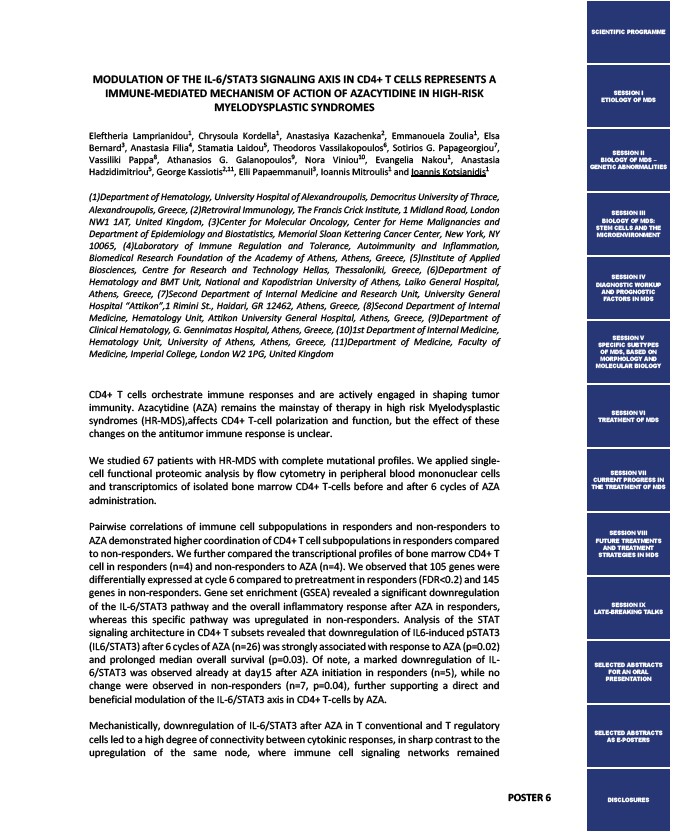
MODULATION OF THE IL-6/STAT3 SIGNALING AXIS IN CD4+ T CELLS REPRESENTS A
IMMUNE-MEDIATED MECHANISM OF ACTION OF AZACYTIDINE IN HIGH-RISK
MYELODYSPLASTIC SYNDROMES
Eleftheria Lamprianidou1, Chrysoula Kordella1, Anastasiya Kazachenka2, Emmanouela Zoulia1, Elsa
Bernard3, Anastasia Filia4, Stamatia Laidou5, Theodoros Vassilakopoulos6, Sotirios G. Papageorgiou7,
Vassiliki Pappa8, Athanasios G. Galanopoulos9, Nora Viniou10, Evangelia Nakou1, Anastasia
Hadzidimitriou5, George Kassiotis2,11, Elli Papaemmanuil3, Ioannis Mitroulis1 and Ioannis Kotsianidis1
(1)Department of Hematology, University Hospital of Alexandroupolis, Democritus University of Thrace,
Alexandroupolis, Greece, (2)Retroviral Immunology, The Francis Crick Institute, 1 Midland Road, London
NW1 1AT, United Kingdom, (3)Center for Molecular Oncology, Center for Heme Malignancies and
Department of Epidemiology and Biostatistics, Memorial Sloan Kettering Cancer Center, New York, NY
10065, (4)Laboratory of Immune Regulation and Tolerance, Autoimmunity and Inflammation,
Biomedical Research Foundation of the Academy of Athens, Athens, Greece, (5)Institute of Applied
Biosciences, Centre for Research and Technology Hellas, Thessaloniki, Greece, (6)Department of
Hematology and BMT Unit, National and Kapodistrian University of Athens, Laiko General Hospital,
Athens, Greece, (7)Second Department of Internal Medicine and Research Unit, University General
Hospital “Attikon”,1 Rimini St., Haidari, GR 12462, Athens, Greece, (8)Second Department of Internal
Medicine, Hematology Unit, Attikon University General Hospital, Athens, Greece, (9)Department of
Clinical Hematology, G. Gennimatas Hospital, Athens, Greece, (10)1st Department of Internal Medicine,
Hematology Unit, University of Athens, Athens, Greece, (11)Department of Medicine, Faculty of
Medicine, Imperial College, London W2 1PG, United Kingdom
CD4+ T cells orchestrate immune responses and are actively engaged in shaping tumor
immunity. Azacytidine (AZA) remains the mainstay of therapy in high risk Myelodysplastic
syndromes (HR-MDS),affects CD4+ T-cell polarization and function, but the effect of these
changes on the antitumor immune response is unclear.
We studied 67 patients with HR-MDS with complete mutational profiles. We applied single-cell
functional proteomic analysis by flow cytometry in peripheral blood mononuclear cells
and transcriptomics of isolated bone marrow CD4+ T-cells before and after 6 cycles of AZA
administration.
Pairwise correlations of immune cell subpopulations in responders and non-responders to
AZA demonstrated higher coordination of CD4+ T cell subpopulations in responders compared
to non-responders. We further compared the transcriptional profiles of bone marrow CD4+ T
cell in responders (n=4) and non-responders to AZA (n=4). We observed that 105 genes were
differentially expressed at cycle 6 compared to pretreatment in responders (FDR<0.2) and 145
genes in non-responders. Gene set enrichment (GSEA) revealed a significant downregulation
of the IL-6/STAT3 pathway and the overall inflammatory response after AZA in responders,
whereas this specific pathway was upregulated in non-responders. Analysis of the STAT
signaling architecture in CD4+ T subsets revealed that downregulation of IL6-induced pSTAT3
(IL6/STAT3) after 6 cycles of AZA (n=26) was strongly associated with response to AZA (p=0.02)
and prolonged median overall survival (p=0.03). Of note, a marked downregulation of IL-
6/STAT3 was observed already at day15 after AZA initiation in responders (n=5), while no
change were observed in non-responders (n=7, p=0.04), further supporting a direct and
beneficial modulation of the IL-6/STAT3 axis in CD4+ T-cells by AZA.
Mechanistically, downregulation of IL-6/STAT3 after AZA in T conventional and T regulatory
cells led to a high degree of connectivity between cytokinic responses, in sharp contrast to the
upregulation of the same node, where immune cell signaling networks remained
POSTER 6
SCIENTIFIC PROGRAMME
SESSION I
ETIOLOGY OF MDS
SESSION II
BIOLOGY OF MDS –
GENETIC ABNORMALITIES
SESSION III
BIOLOGY OF MDS:
STEM CELLS AND THE
MICROENVIRONMENT
SESSION IV
DIAGNOSTIC WORKUP
AND PROGNOSTIC
FACTORS IN MDS
SESSION V
SPECIFIC SUBTYPES
OF MDS, BASED ON
MORPHOLOGY AND
MOLECULAR BIOLOGY
SESSION VI
TREATMENT OF MDS
SESSION VII
CURRENT PROGRESS IN
THE TREATMENT OF MDS
SESSION VIII
FUTURE TREATMENTS
AND TREATMENT
STRATEGIES IN MDS
SESSION IX
LATE-BREAKING TALKS
SELECTED ABSTRACTS
FOR AN ORAL
PRESENTATION
SELECTED ABSTRACTS
AS E-POSTERS
DISCLOSURES